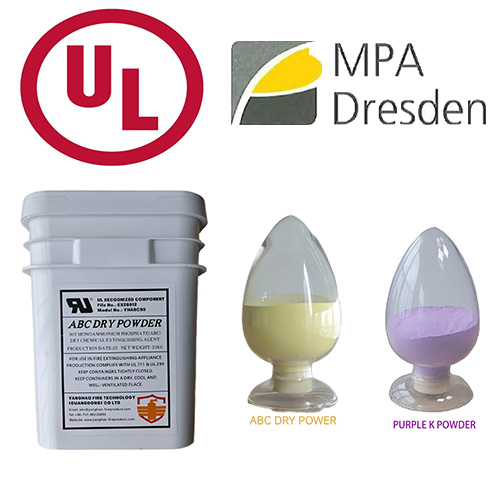Aging in Storage: How Dry Chemical Fire Extinguishing Agents Lose Their Power Over Time
1. Introduction
Even the best dry chemical powder is not immune to time.While most extinguishers sit idle for years, their contents undergo subtle physical and chemical changes that can seriously impact fire suppression efficiency.
The ABC fire extinguishing agent, widely used in both industrial and residential fire protection systems, relies on stable chemical properties to interrupt combustion effectively. Yet when stored under improper conditions, it can experience storage aging — a process that reduces its ability to extinguish fires quickly and safely.
This article explores how chemical degradation and environmental factors affect dry chemical powder over time, and what can be done to maintain performance during long-term storage.
2. Understanding Storage Aging in Fire Extinguishing Agents
Storage aging refers to the gradual deterioration of physical and chemical properties in a dry chemical powder over prolonged storage.
The main causes include humidity, temperature fluctuation, and internal pressure imbalance inside the extinguisher cylinder.
When these factors interact, they initiate chemical degradation within the ABC fire extinguishing agent, particularly affecting compounds like monoammonium phosphate (MAP) and ammonium sulfate. These materials are sensitive to moisture and can form crystal bridges, leading to powder clumping.
Over time, the flow rate decreases, and the fire suppression efficiency drops significantly—sometimes by more than 20% after two years of poor storage.
3. Key Factors Contributing to Powder Aging
The storage aging of dry chemical powder is not random—it’s driven by several predictable environmental and chemical mechanisms:
Humidity and Moisture Ingress
Even minimal chemical degradation can begin when ambient humidity exceeds 60%. The powder absorbs moisture, leading to caking and loss of fluidity.Temperature Cycling
Repeated exposure to high and low temperatures causes condensation, which accelerates storage aging.Container Corrosion
If the cylinder’s inner wall corrodes, metallic ions can react with the ABC fire extinguishing agent, triggering chemical degradation.Static Charge and Settling
Vibration during transport or long-term storage causes fine particles to settle, forming compact layers that disrupt consistent discharge during operation.
Together, these factors can reduce fire suppression efficiency well before the product’s nominal shelf life ends.
4. How Chemical Degradation Reduces Fire Suppression Efficiency
The fire suppression efficiency of an ABC fire extinguishing agent depends on both its thermal decomposition behavior and its ability to form a protective barrier over the burning surface.
During storage aging, chemical degradation alters these reactions in several ways:
Reduced Decomposition Rate: Aged powders release less ammonia gas during heating, slowing the interruption of the flame chain reaction.
Impaired Layer Formation: Caked particles cannot spread evenly, limiting the insulating barrier that separates oxygen from the flame.
Contaminated Residue: Corrosion or humidity introduces impurities that destabilize the dry chemical powder, further diminishing efficiency.
In comparative tests, a new ABC fire extinguishing agent achieved complete flame knockdown in 4 seconds, while an aged one under high humidity took nearly 7 seconds — a 40% performance loss due to chemical degradation.
5. Storage Best Practices to Prevent Aging
Maintaining storage stability requires strict environmental control and quality management.
Here are best practices to extend the shelf life of any dry chemical powder or ABC fire extinguishing agent:
Maintain Ambient Humidity Below 50%
Prevent moisture-driven chemical degradation and clumping.Avoid Temperature Extremes
Store cylinders in shaded, temperature-stable environments between 15°C and 30°C.Rotate Inventory Every 12 Months
Use a “first in, first out” system to minimize storage aging.Inspect Pressure Gauges and Weight Regularly
Any unexplained loss indicates possible leakage or degradation inside the container.Test Samples Periodically
Manufacturers like Yanghao Fire Technology conduct semi-annual lab tests to verify powder flowability and fire suppression efficiency retention.
Following these preventive measures can double the effective lifespan of a dry chemical powder without compromising safety or performance.
6. Advanced Formulation: Slowing Down Aging
Leading manufacturers now use additives and surface coatings to resist storage aging.
At Yanghao Fire Technology, the UL-certified ABC fire extinguishing agent includes anti-caking agents and hydrophobic coatings that reduce chemical degradation by up to 60%. These protective technologies prevent moisture penetration, improve fire suppression efficiency, and extend product durability—even in humid regions.
Independent lab results show that after 12 months of accelerated aging, Yanghao’s coated dry chemical powder maintained 95% of its original extinguishing capacity, while uncoated powders retained only 78%.
7. Conclusion
Storage aging is an invisible threat to the reliability of every dry chemical powder.
As time passes, subtle chemical degradation can severely compromise fire suppression efficiency, especially when environmental controls are neglected.
To ensure long-term performance, proper storage conditions, regular inspections, and high-quality formulations are essential.
Manufacturers like Yanghao Fire Technology are taking the lead by developing advanced ABC fire extinguishing agents that resist humidity, temperature fluctuation, and oxidation—delivering stable and trustworthy fire protection even after years in storage.



